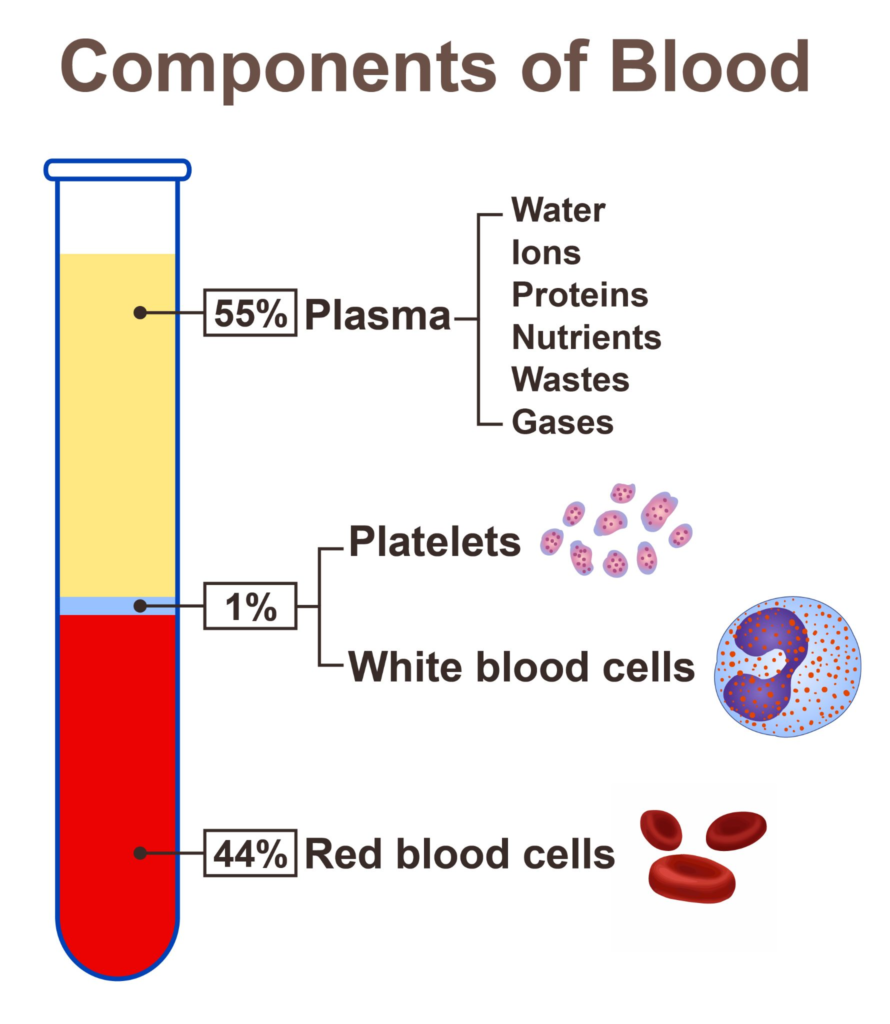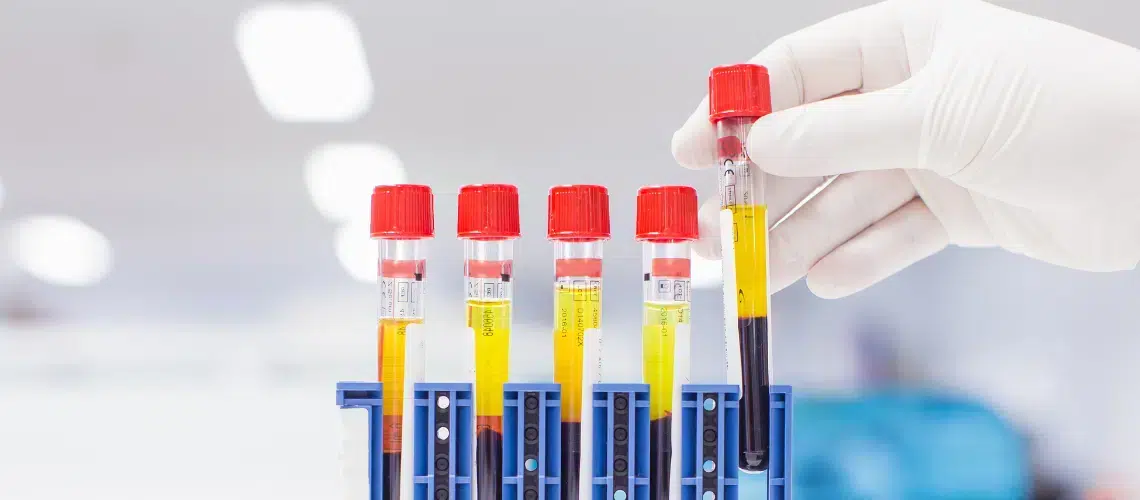Hemolysis can occur when red blood cells within a blood sample break down or burst. This can happen both within the body due to a range of medical conditions, or outside the body during blood sample collection. This article will focus on the topic of hemolysis in blood testing. Hemolysis can occur during the collection, handling, or processing of a blood sample, and can happen to any blood test regardless of whether it was collected in a doctor’s office, hospital, or at home. A blood sample that has hemolyzed is often not suitable for analysis, meaning the test result may be invalid and the sample will need to be taken again. As finger prick blood samples are used in Homed-IQ’s blood tests, hemolysis is an important topic that we aim to help test users avoid. Learn more about what hemolyzed blood is, how it occurs, and how to avoid it in this article.
The components of blood
While blood looks like a red liquid to the human eye, it is made up of four main components that each have important roles. Blood consists of red blood cells, which carry oxygen to tissues and remove carbon dioxide; white blood cells, which form a crucial part of the immune system and protect the body against infections; platelets, which help in blood clotting and wound healing; and plasma, a yellowish fluid that carries nutrients, hormones, and waste products throughout the body (ASH, 2023). Together, these components work in harmony to support numerous physiological processes and maintain optimal well-being.

How does hemolysis affect blood test results?
When red blood cells hemolyze, they burst and release their contents into the blood plasma (Wan Azman at el., 2019). These contents include hemoglobin and other substances. If blood plasma is contaminated with the contents of red blood cells, measurement of certain biomarkers can be impacted, causing an inaccurate test result. As such, laboratory technicians check all blood samples for hemolysis and will request for the sample to be repeated if evidence of hemolysis occurs. If your Homed-IQ blood sample is hemolyzed, you will receive an error message that the test result was insufficient. You will then have the opportunity to request a replacement test free of charge.
Causes of Hemolysis
Hemolysis can occur due to various factors during the blood testing process. However, most hemolysis occurs during sample collection and transport. Read on to learn the most common causes of hemolysis and how to avoid them with your Homed-IQ blood sample.
Errors in blood sample collection
One of the most common causes of hemolysis is due to the method in which the blood was collected. In blood drawn from veins (venipuncture), this can occur due to an incorrect needle size, pulling back or pushing too hard on a syringe plunger, or using a tourniquet for too long. In finger prick blood collection, pressing too hard on the fingertip or “milking” the blood from the site of the needle puncture can cause hemolysis to occur. As such, Homed-IQ always recommends massaging the base of the finger to stimulate blood flow, rather than pressing directly on the fingertip. If you are struggling to get adequate blood from a finger prick site, consider using another lancet to prick another finger.
Inadequate handling:
Mishandling or improper storage of blood samples can also cause hemolysis. Factors such as exposure to extreme temperatures and shaking or vigorous mixing of the sample can cause red blood cells to rupture. While it is recommended to gently invert all Homed-IQ blood samples to allow the blood to mix with the preservative liquid in the sample collection tube, it is important not to shake too hard. Additionally, if there are extremely hot or cold temperatures outside, it’s a good idea to bring your test sample directly to the post office, or to wait until after the weekend to drop it in the mailbox so that it is not sitting outdoors for long periods of time.
Prolonged storage
It is also advised to mail your sample to the laboratory as soon as it is collected, as the possibility of the sample hemolyzing or coagulating (turning from a liquid to a solid) increases the longer the sample is in transport. Homed-IQ strives to process most blood test samples within 24 hours of reaching the laboratory in order to minimise the chance of storage-related hemolysis. It is also extremely important to activate your test before mailing it to the laboratory so that there are no delays in the analysis of the sample.
How are hemolyzed blood samples detected in the lab?
Laboratory professionals are trained to identify hemolyzed blood samples. The blood sample is first prepared and centrifuged (spun at a high speed) to remove the components that are involved in blood clotting, producing a liquid known as serum. The serum is then inspected by the laboratory technician and compared to a hemolytic index chart, which shows the acceptable colours of serum samples and the colour of samples that have hemolyzed. Hemolysis causes serum to be red in colour, as destroyed blood cells release hemoglobin (CDC, 2023). Serum samples that match the colour of hemolyzed samples on the index chart should not be used.

Source: CDC, 2023
How can I stop my blood sample from hemolyzing?
Following the test instructions closely is the best way to prevent hemolysis in your blood sample. This means taking the time to warm up your hands and carefully extract the blood from the finger prick into the collection tube. For more detailed tips on how to have a successful blood sample, see our Blood Collection Tips page. Would you like to see an example of how to collect the sample? View the instruction video here.
What happens if my blood sample is hemolyzed?
If your Homed-IQ test sample has hemolyzed, please contact our customer service team. They will arrange a replacement test and advise you on how to have a successful second blood sample.
References
American Society of Hematology. (2021). Hematology Glossary. Hematology.org. https://www.hematology.org/education/patients/blood-basics#:~:text=It%20has%20four%20main%20components,to%20prevent%20excess%20blood%20loss
Azman, W., Omar, J., Koon, T. H., & Ismail, T. N. M. T. (2019). Hemolyzed Specimens: Major Challenge for Identifying and Rejecting Specimens in Clinical Laboratories. Oman Medical Journal, 34(2), 94–98. https://doi.org/10.5001/omj.2019.19
Centers for Disease Control and Prevention. (2023, March 3). A Quick-Reference Tool for Hemolysis Status. https://www.cdc.gov/ncezid/dvbd/stories/research-lab-diagnostics/hemolysis-palette.html




